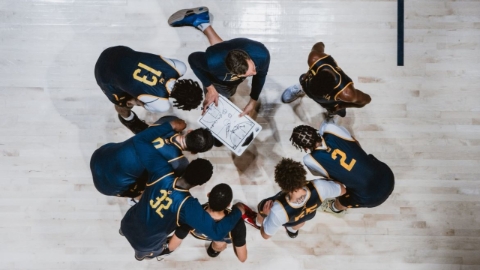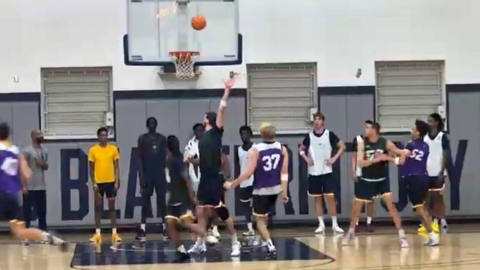
When Cal left Maples Pavilion on January 2 after a 68-52 drubbing by the Stanford Cardinal, Cal fans everywhere likely had the sinking feeling of here we go again. After a promising 4-0 start to begin the season, Cal went 2-8 over the next 10 games sinking to 6-8 overall and 0-1 in the early Pac-12 season.
But then Cal came back to Haas Pavilion in Berkeley and swept the Washington schools, setting off a bipolar conference season with unexpected wins (at Washington State, home against Colorado) and frustrating losses (at UCLA and at Washington). But overall, the Bears looked to improve and finished the season 4-3 in its last seven games with a home sweep of Colorado and Utah, a road win at Wazzu and that sweet rubber match win over Stanford in the first round of the Pac-12 Tournament in Las Vegas.
While the Bears passed the eye-ball test of looking better at times, what do the stats and data say?
| Stats | Cal (non-con) | Opponents (non-con) | Cal (con) | Opponents (con) |
|---|---|---|---|---|
| FG% | 45.13% | 41.01% | 39.88% | 44.58% |
| 2P% | 47.60% | 44.80% | 43.51% | 50.09% |
| 3P% | 37.80% | 36.50% | 31.23% | 36.02% |
| FT% | 72.20% | 75.30% | 74.62% | 72.78% |
| ORB per Game | 8.00 | 10.38 | 8.56 | 8.00 |
| DRB per Game | 27.69 | 25.38 | 23.67 | 25.11 |
| TRB per Game | 35.69 | 35.76 | 32.22 | 33.11 |
| Ast per Game | 10.08 | 12.08 | 9.06 | 12.78 |
| Stl per Game | 4.31 | 4.38 | 4.06 | 5.56 |
| TO per Game | 14.31 | 12.54 | 12.39 | 11.39 |
| PF per Game | 20.38 | 20.23 | 18.67 | 17.11 |
| Pts per Game | 63.2 | 69.1 | 61.3 | 69.6 |
In a lot of statistical categories, Cal actually got worse in conference play. Considering the competition improved significantly from non-conference to conference play, it’s not a surprise. As you can see from the chart above, Cal’s field goal percentage dropped significantly from 45.13% in non-conference play compared to 39.88% in the Pac-12. Meanwhile, non-conference opponents shot just 41.01% from the field against the Bears while Pac-12 teams shot 44.58%. In particular, Cal’s three-point shooting fell from 37.8% against non-conference opponents to 31.23% in the Pac-12.
Other than that, Cal did a slightly better job of hitting the offensive glass and keeping opponents off the offensive glass. Overall, though, the rebounding gap between Cal and its opponents grew slightly from non-conference to Pac-12 play. Cal did improve by turning it over about two times less per game in conference play versus non-conference play. The Bears also fouled less but drew less fouls as well. Cal also scored about two points less per game in conference play while giving up about a half of a point more.
| Advanced Stats | Cal Off. (non-con) | Cal Def. (non-con) | Cal Off. (con) | Cal Def. (con) |
|---|---|---|---|---|
| Adj. Eff. | 99.3 | 100.8 | 100.6 | 98.3 |
| eFG% | 50.00% | 48.50% | 44.50% | 51.60% |
| TO% | 19.70% | 17.60% | 18.80% | 17.20% |
| OR% | 24.90% | 28.80% | 25.80% | 25.40% |
| FTR | 37.9 | 34.6 | 34.4 | 39 |
| Block % | 8.90% | 7.80% | 10.0% | 7.3% |
| 3P Rate | 26.8 | 37.6 | 29.6 | 39.1 |
| Assist Rate | 41.1 | 48.9 | 42.4 | 54.2 |
Looking at advanced stats, however, shows Cal did make some improvements in Pac-12 play. Cal’s offensive efficiency climbed from 99.3 to 100.6. And it’s defensive efficiency improved, even more, going from 100.8 to 98.3. Cal was shooting at a worse percentage (50.0% compared to 44.5% in eFG%), but it was also turning it over at a lower rate, grabbing offensive rebounds at a higher rate, and getting assists at a higher rate.
On defense, Cal did a much better job at keeping teams off the offensive glass (28.8% opponent offensive rebounding rate in non-conference and 25.4% in Pac-12 play). On the other hand, Pac-12 opponents shot slightly better than non-conference opponents and had a higher free-throw rate.
| Player | Game Score (All) | Game Score (Con.) | ORtg (All) | ORtg (Con.) | Usg% (All) | Usg% (Con.) | eFG% (All) | eFG% (Con.) | FTR (All) | FTR (Con.) |
|---|---|---|---|---|---|---|---|---|---|---|
| Matt Bradley (2020) | 10.56 | 10.46 | 106.8 | 105.9 | 27.50% | 27.10% | 51.70% | 51.60% | 36.5 | 29.6 |
| Paris Austin (2020) | 5.77 | 7.09 | 92.1 | 96.6 | 23.40% | 24.00% | 40.10% | 39.50% | 51.9 | 53.1 |
| Andre Kelly (2020) | 5.34 | 5.56 | 104.4 | 102.1 | 19.10% | 18.50% | 55.50% | 55.70% | 31.5 | 32 |
| Kareem South (2020) | 4.81 | 2.42 | 94.6 | 78.5 | 18.20% | 17.40% | 41.70% | 37.10% | 22.4 | 17.1 |
| Grant Anticevich (2020) | 4.46 | 4.26 | 90.2 | 86.2 | 18.10% | 19.00% | 46.00% | 42.00% | 13 | 11.7 |
| Juhwan Harris-Dyson (2020)* | 2.09 | N/A | 84 | N/A | 20.90% | N/A | 43.50% | N/A | 45.7 | N/A |
| Kuany Kuany (2020) | 1.63 | 2.11 | 110.5 | 118.2 | 18.70% | 19.00% | 45.80% | 48.30% | 116.7 | 110 |
| Lars Thiemann (2020) | 1.41 | 0.67 | 86.2 | 77.6 | 14.50% | 14.90% | 55.90% | 58.80% | 57.4 | 38.2 |
| Joel Brown (2020) | 1.26 | 1.28 | 78.2 | 83.6 | 12.90% | 10.90% | 39.50% | 38.50% | 34.9 | 51.3 |
| Jacobi Gordon (2020)* | 1.07 | N/A | 86.7 | N/A | 17.60% | N/A | 45.00% | N/A | 40 | N/A |
| D.J. Thorpe (2020) | 1.04 | 0.87 | 80.8 | 74.9 | 16.60% | 16.70% | 48.60% | 38.50% | 82.9 | 88.5 |
| Dimitrios Klonaras (2020) | 0.43 | 0.68 | 90 | 88.8 | 13.80% | 16.30% | 48.60% | 60.00% | 45.5 | 50 |
Individually, Paris Austin improved the most in Pac-12 play compared to non-conference play, according to the Game Score. Overall on the season, Paris Austin had a Game Score of 5.77. But in Pac-12 games only, he had a score of 7.09. His improvement in terms of efficiency and what he contributed to the team was noticeable and impressive and probably adds directly to a few conference wins (home against Utah stands out as an example, despite missing what would’ve been game-winning free-throws in regulation).
On the other side, Kareem South digressed the most in non-conference play to Pac-12 play. Overall this season, South had a Game Score of 4.81. But when parsing out Pac-12 games only, South’s Game Score drops to 2.42. South’s offensive rating plummeted from 94.6 for all games to just 78.5 in conference play. It’s possible that if South could’ve played in Pac-12 play like he did in conference play the Bears actually add a couple more wins.
So with Cal not really improving much in the regular statistical categories and just slightly in the advanced stats, what’s to make of Cal’s improved 7-11 Pac-12 record? It’s tough to say exactly. As a whole, the conference was the best it’s been since the 2015-2016 season when Cal finished in fourth place with a 12-6 record, according to KenPom. Last year was the weakest the conference has been by KenPom’s metrics since the 2003-2004 season and the Bears went 0-15 before an improbably three-game win streak to close the season.
First, there has to be something to say about coaching. I don’t like going out of the way to put down college coaches because they’re human beings and want their teams to win more than any fan, but so far, Mark Fox and his staff are clearly stronger than the previous staff. They did more with a roster that was, on paper, less talented than the previous season.
There is also something to say about winning and scheduling. Last season, Cal started with three out of its first four games away from Haas Pavilion and went 1-3 with its only win coming against Hampton in Berkeley. This season, the Bears didn’t leave Berkeley until its fifth game when they were 4-0. There was time to build some confidence and get a taste of winning. That goes a long ways, especially for 19- to 22-year-old young men.
Lastly, Cal had some luck in closing games. Overall, Cal had a losing record (14-18) but went 3-0 in overtime games and 7-4 in games decided by six points or less. Torvik’s rankings put Cal at No. 53 in the nation in “close games” with an 8-4 record.
So did Cal improve from non-conference to Pac-12 play? Yes. And no. But more importantly, it stayed competitive. And even at the end of the season when there wasn’t an NCAA Tournament or even likely NIT opportunity, the Bears kept grinding and stealing some wins. And for this season, that was enough.
Other End-of-Season Recaps:
Fox Reflects on Season, Expects No More Departures
Advanced Stats Definitions:
Adjusted Offensive Efficiency: How much a team would score in 100 possessions against the average college team.
Adjusted Defensive Efficiency: How much a team would allow an opponent to score in 100 possessions against the average college team.
eFG%: A shooting calculation giving extra weight to three-point shooting. Calculation is: (2pt FGM + 1.5*3pt FGM) / FGA
TO%: Estimate of turnovers per 100 plays.
OR%: Estimate of offensive rebounds per 100 plays.
Block %: Estimate of blocks per 100 plays.
FTR: Ratio of foul shots to field goal attempts.
3P Rate: Ratio of three-point attempts to field goal attempts.
Assist Rate: Percentage of possessions that end in an assist.
Game Score: The Game Score measures a player’s efficiency and productivity during a game. The formula is PTS + 0.4 * FG - 0.7 * FGA - 0.4*(FTA - FT) + 0.7 * ORB + 0.3 * DRB + STL + 0.7 * AST + 0.7 * BLK - 0.4 * PF - TOV.
Usg%: An estimate of the percentage of team plays used by a player while he/she is on the floor.



